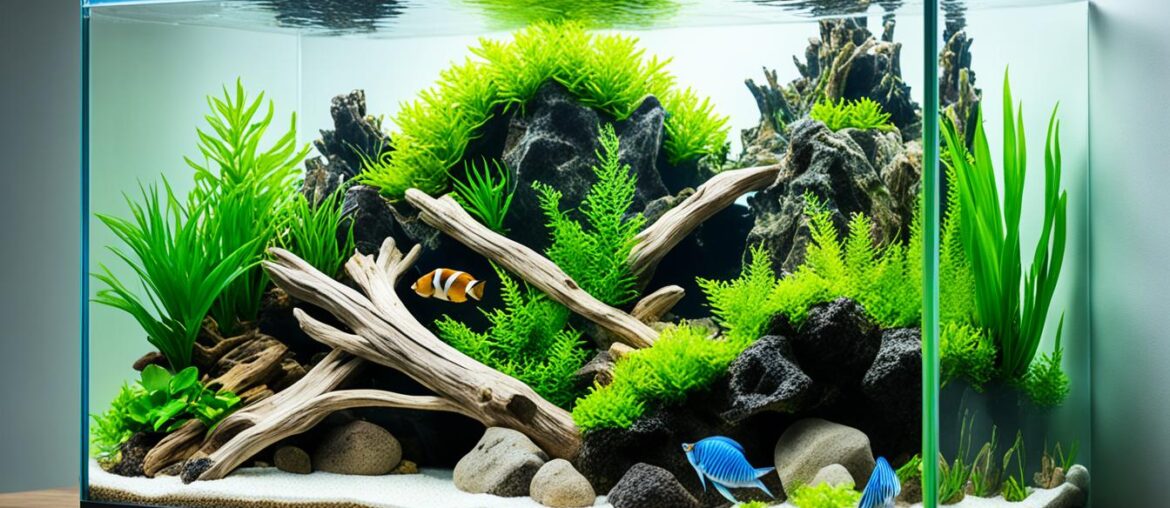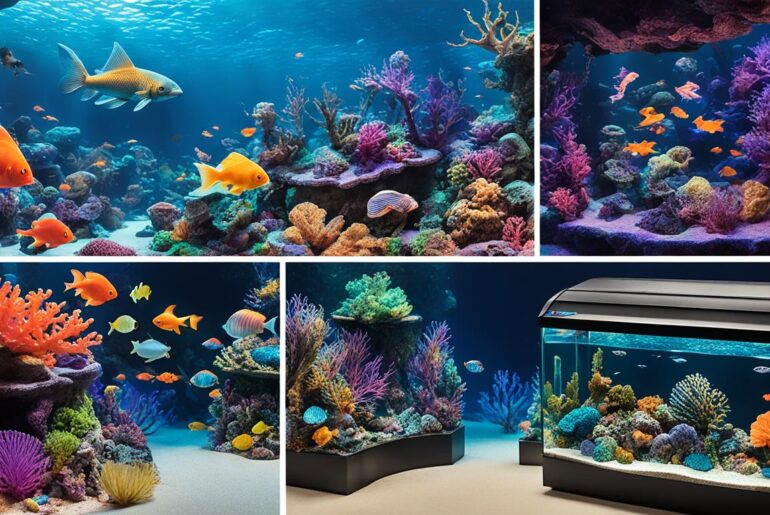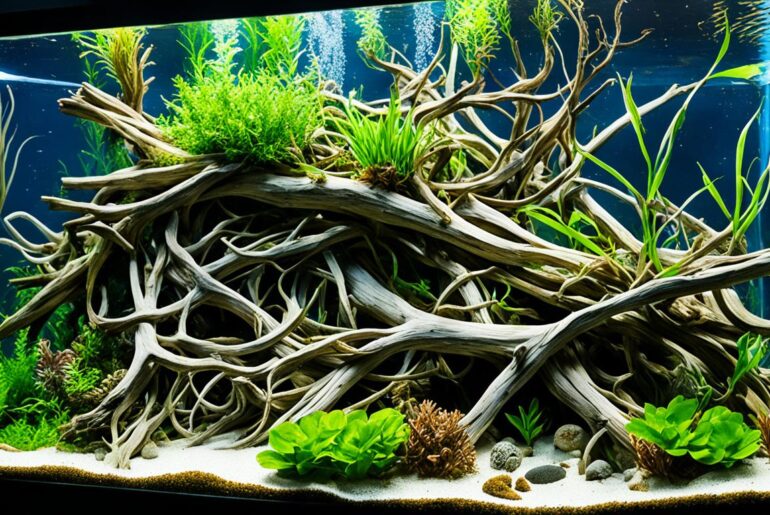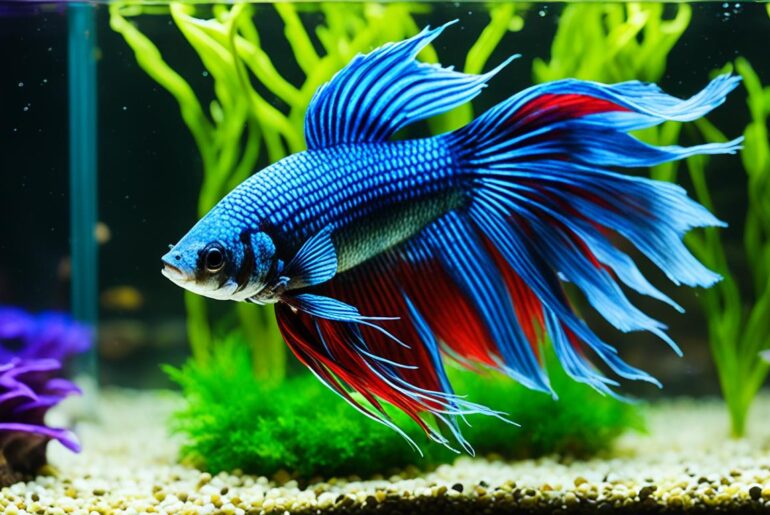Have you ever looked at a beautifully decorated aquarium and felt a sense of wonder and tranquility? I have. There’s something truly mesmerizing about watching colorful fish swim among carefully crafted underwater landscapes.
As an avid aquarium enthusiast, I’ve spent countless hours creating my own DIY aquarium decorations. But there’s one thing I’ve learned through trial and error – the importance of choosing safe materials for my aquatic friends.
Just like we value the safety and well-being of our pets, we must ensure that our aquarium inhabitants are living in a healthy and non-toxic environment. It’s not just about creating a visually stunning underwater paradise; it’s about providing a safe haven for our fish to thrive.
In this article, I’ll guide you through the process of selecting the best materials for your DIY aquarium decor projects. From choosing the right adhesives to considering the use of different materials, we’ll explore all the necessary steps to create a beautiful and safe aquarium for your aquatic companions.
Key Takeaways:
- Choosing safe materials is crucial for the health and well-being of your aquatic friends.
- Research the best adhesives for aquarium use, such as cyanoacrylate glue, silicone sealant, epoxy, or hot glue guns.
- Avoid using materials that can leach harmful chemicals into the water, such as certain metals or painted/glazed glass.
- Repurpose household objects or explore hardware stores for unique DIY aquarium decoration ideas.
- Unleash your creativity with Legos or make your own DIY decorations using non-toxic materials.
Choosing the Right Glue or Adhesive for Aquarium Decor
When it comes to securing your DIY aquarium decorations, it’s essential to choose the right glues and adhesives that are safe for your aquatic environment. Different materials require specific types of adhesive to ensure a strong and long-lasting bond. Here are some options to consider:
- Cyanoacrylate Glue: Also known as “Reef Glue” or “Super Glue,” cyanoacrylate glue is a popular choice among aquarists and reef hobbyists. It is perfect for bonding plastic materials, such as artificial plants or ornaments. Ensure that the glue is labeled aquarium-safe and free of any harmful additives. Keyword: Cyanoacrylate Glue
- Silicone Sealant: Silicone sealant is a durable adhesive that becomes flexible once cured, making it suitable for assembling and securing ornaments and pieces within the aquarium. It provides a watertight seal and works well on glass, acrylic, and non-porous surfaces. Look for aquarium-grade silicone sealants that are safe for aquatic life. Keyword: Silicone Sealant
- Epoxy: Underwater epoxy is a two-part adhesive that is great for creating rockwork formations or attaching rocks and driftwood to each other or the aquarium glass. It provides a strong bond and is resistant to water and changes in temperature. Make sure to choose epoxy specifically formulated for underwater use. Keyword: Epoxy
- Hot Glue Guns: Hot glue guns are popular among freshwater aquarium hobbyists due to their ease of use and non-toxic nature. They are great for quick fixes or attaching lightweight decorations. However, they may not be suitable for saltwater or reef tanks as the glue may break down over time. Keyword: Hot Glue Guns
- Water-soluble Glues: Avoid using water-soluble glues, such as white craft glue, for aquarium decorations. These glues do not cure underwater and can affect water quality, potentially harming your fish and other aquatic inhabitants. Stick to adhesive options that are specifically designed for aquarium use. Keyword: Water-soluble glues
Remember that before applying any adhesive, ensure that the surfaces to be bonded are clean and free from algae, oils, or debris. Follow the manufacturer’s instructions for application and curing times to achieve the best results. Always prioritize the safety of your aquatic friends by choosing aquarium-safe glues and adhesives.
Below is a table summarizing the different glues and adhesives suitable for aquarium decor:
| Glue/Adhesive | Best for | Aquarium Compatibility |
|---|---|---|
| Cyanoacrylate Glue | Bonding plastic materials | Safe for aquarium use* |
| Silicone Sealant | Securing ornaments and pieces | Aquarium-grade sealant recommended |
| Epoxy | Creating rockwork formations | Choose underwater-specific epoxy |
| Hot Glue Guns | Quick fixes in freshwater tanks | Non-toxic, but not ideal for saltwater tanks |
| Water-soluble Glues | Not recommended for aquarium use | Avoid using |
*Always check the label and choose aquarium-safe versions of the glue or adhesive.
Using Clear-coats, Enamel, and Acrylic for Aquarium Decor
When it comes to adding color and protection to your DIY aquarium decorations, clear-coats, enamel paints, and acrylic paints are popular choices. Each of these options offers unique benefits and considerations that can enhance the visual appeal of your underwater world.
Clear-coats: Versatile and Protective
Clear-coat paints and sealers are commonly used in various crafts and DIY projects, including aquarium decor. They provide a transparent layer that adds shine and protection to the surface of your decorations. However, it’s important to note that while clear-coats can cover unsafe materials, they do not guarantee the safety of the underlying material itself. It’s crucial to ensure that the base materials are aquarium-safe before applying a clear-coat.
Enamel Paints: Durable and Underwater-friendly
If you’re looking for a durable paint option for underwater use, enamel paints are an excellent choice. Once fully dried and cured, enamel paints create a hard, protective coating that can withstand submersion in water. They come in a variety of vibrant colors and finishes, allowing you to unleash your creativity and personalize your aquarium decor. Be sure to follow the manufacturer’s instructions for drying and curing to ensure the longevity and safety of the enamel-painted decorations.
Acrylic Paints: Water-resistant and Widely Available
Acrylic paints are another popular option among hobbyists for decorating aquariums. These water-based paints offer excellent adhesion and are resistant to water once dry. The Krylon Fusion line of acrylic paints is especially favored by aquarium enthusiasts due to its high-quality formula and suitability for underwater use. With a wide range of colors available, acrylic paints provide endless possibilities for creating unique designs and accents in your aquarium.
Note: Always opt for paints that are labeled as non-toxic or safe for aquarium use to ensure the well-being of your fish.
Below is a table summarizing the key features and considerations of using clear-coats, enamel paints, and acrylic paints for aquarium decor:
| Paint Type | Benefits | Considerations |
|---|---|---|
| Clear-coats | Provides shine and protection | Does not guarantee underlying material safety |
| Enamel Paints | Durable and suitable for underwater use | Follow drying and curing instructions for optimal safety |
| Acrylic Paints | Water-resistant and widely available | Choose non-toxic paints labeled for aquarium use |
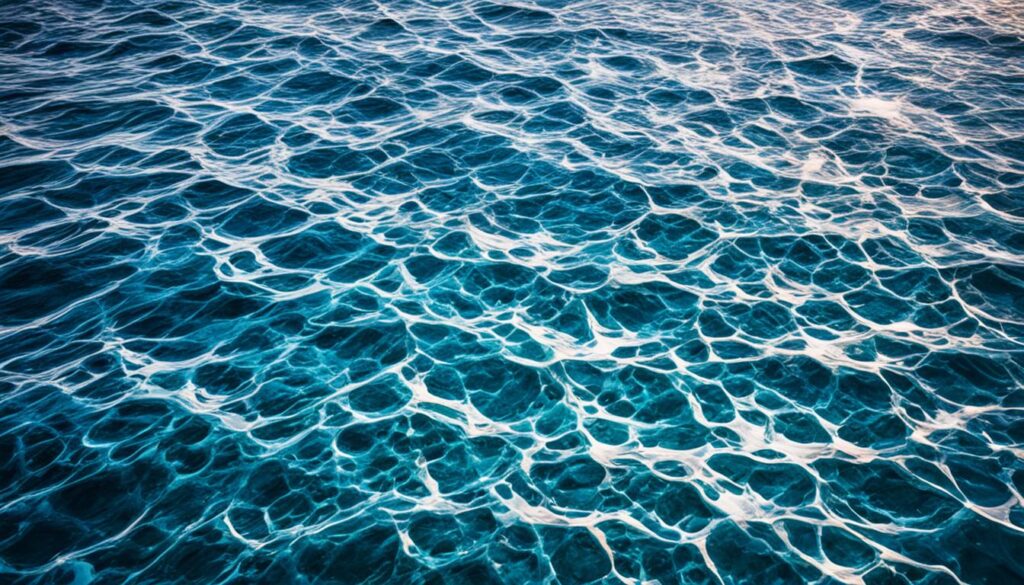
With the right choice of clear-coats, enamel paints, or acrylic paints, you can transform ordinary materials into stunning aquarium decorations. Remember to prioritize the safety of your fish by using non-toxic paints and ensuring that the underlying materials are suitable for an aquatic environment.
Considering the Use of Metal, Natural/Organic Materials, Rocks/Minerals, and Glass
When it comes to DIY aquarium decorations, the choice of materials is crucial. Not all materials are suitable for underwater environments and can impact water quality. Let’s explore the considerations for using metal, natural/organic materials, rocks/minerals, and glass in your aquarium decor.
Metal
Avoid using metal in your aquarium decorations. Metal can leach harmful chemicals into the water, posing a threat to the health of your aquatic pets. Additionally, metal can conduct electricity, introducing further risks to the aquarium environment.
Natural/Organic Materials
Exercise caution when using natural/organic materials in aquarium decor. While these materials may initially seem suitable, they can decompose over time, affecting water pH and hardness. Some organic materials can release substances that are harmful to fish and other aquatic life. Prioritize the safety and stability of your aquarium ecosystem by selecting non-decomposable materials.
Rocks/Minerals
Test rocks and minerals before adding them to your aquarium. Rocks and minerals can vary in their impact on water quality. Some may contain substances that are harmful to aquatic life, while others may alter water chemistry. Conduct a thorough testing process to ensure that the rocks and minerals you choose meet the needs of your aquarium inhabitants.
Glass
Plain glass is a safe option for aquarium decor, whereas painted or glazed glass may pose risks. Plain glass is chemically inert and does not release harmful substances into the water. However, painted or glazed glass may contain chemicals that can leach into the aquarium environment, jeopardizing the health of your fish. Exercise caution when using painted or glazed glass in your aquarium decor.
| Material | Suitability for Aquarium Decor | Potential Impact on Water Quality |
|---|---|---|
| Metal | Avoid | Leaching harmful chemicals, electrical conductivity |
| Natural/Organic Materials | Use with caution | Decomposition, changes in water pH and hardness |
| Rocks/Minerals | Test before use | Potential for harmful substances, alteration of water chemistry |
| Glass | Safe (plain glass), exercise caution (painted/glazed glass) | No impact (plain glass), potential release of harmful substances (painted/glazed glass) |
Using Household Objects for DIY Aquarium Decorations
Repurposing household objects is a creative way to add a personal touch to your DIY aquarium decor. By incorporating items you already have at home, you can create a unique underwater environment for your fish. Let’s explore some household objects that can be transformed into captivating aquarium decorations.
Plastics
Toys and other plastic items can be repurposed to create a variety of aquatic scenes in your tank. From pirate ships to underwater castles, the possibilities are endless. Make sure to thoroughly clean and rinse the plastics before introducing them to the aquarium. Avoid sharp edges and any parts that could potentially harm your fish.
Note: It’s essential to ensure that the plastics you use are aquarium-safe and do not contain any harmful chemicals that could leach into the water. Performing thorough research on the materials and their impact on water quality is crucial to the well-being of your fish.
Flowerpots and Vases
Flowerpots and vases can serve as excellent hiding spots and caves for your fish. Consider using ceramic or glass containers that are safe for aquatic use. You can arrange them in various ways to create a visually appealing and functional underwater landscape. Remember to wash the flowerpots and vases thoroughly before placing them in the aquarium to ensure they are free from any harmful substances.
Ceramic Mugs
Ceramic mugs provide an interesting option for aquarium decor. With their unique shapes and designs, they can add character to your underwater environment. Fish love to explore and seek shelter in small, enclosed spaces, making ceramic mugs ideal hiding spots. Make sure the mugs are thoroughly cleaned and have no sharp edges that could harm your fish.
Remember, when using household objects for DIY aquarium decorations, it’s important to prioritize the safety and well-being of your fish. Ensure that the materials are aquarium-safe, thoroughly cleaned, and free from any potential hazards. With a bit of creativity and careful consideration, you can create a visually stunning and fish-friendly underwater world using items you already have at home.
Finding DIY Decoration Ideas at Hardware Stores
If you don’t have suitable items at home, a hardware store or garden center can be a great source for DIY aquarium decorations. The diverse range of products available can help you create a unique and captivating underwater environment for your fish. Here are some ideas to inspire you:
Lawn Ornaments
Turn your aquarium into a whimsical underwater garden by incorporating lawn ornaments. Garden gnomes, stone animals, and other decorative figurines can add a touch of charm and create interesting scenes within your tank. Just make sure to choose ornaments made from materials that are safe for aquarium use.
Flower Pots or Vases
Flower pots and vases can be transformed into attractive aquarium decorations. Consider using them as hiding spots for your fish or as platforms for aquatic plants. Don’t forget to rinse them thoroughly and ensure they are free from any substances that could harm your fish.
PVC Piping
Enhance the habitat of your fish by incorporating PVC piping into your DIY aquarium decor. These pipes can be used to create tunnels, caves, and hiding spots, providing your fish with a sense of security. Just make sure to choose pipes with smooth edges and clean them thoroughly before adding them to your tank.
Remember, the possibilities are endless when it comes to finding DIY decoration ideas at hardware stores. Let your creativity flow and enjoy the process of creating a unique and personalized underwater world for your fish.
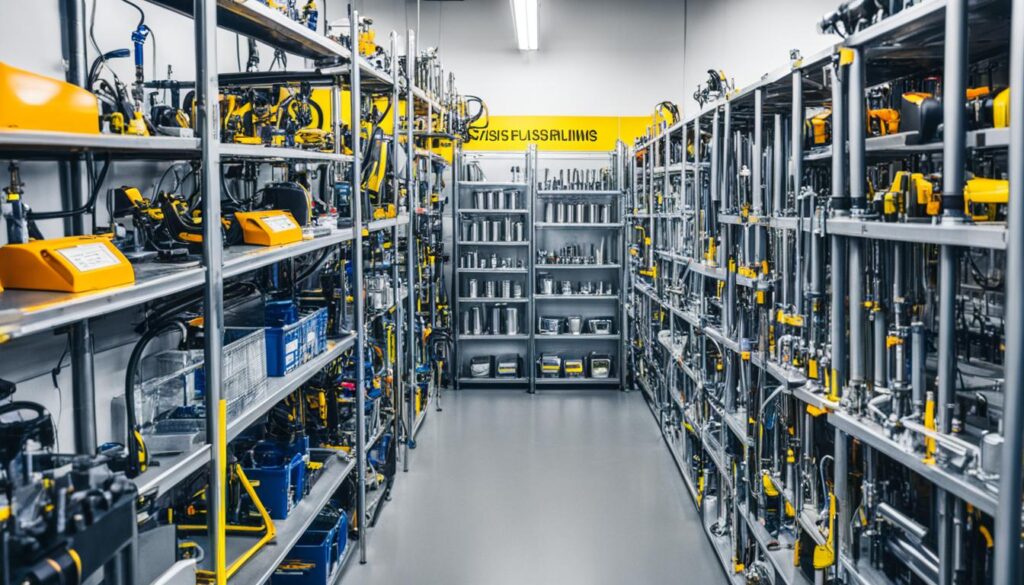
Unleashing Creativity with Legos for Aquarium Decor
Legos offer endless possibilities for DIY aquarium decorations. They are safe to use in water and allow for creative designs. Whether you’re a seasoned Lego enthusiast or a beginner, incorporating Legos into your aquarium can bring a unique flair to your underwater environment.
If you’re a fan of official Lego sets, you can follow their instructions to build aquatic-themed structures and characters. These sets often include fish, coral reefs, submarines, and more, providing a ready-to-use option for your aquarium decor.
For those seeking a more personalized touch, you can unleash your creativity and construct your own Lego structures. With a random selection of blocks, you can design unique underwater landscapes, caves, or even replicas of famous landmarks. Let your imagination run wild!
When building larger Lego structures, it’s important to ensure that all air bubbles are removed. Air pockets can cause the decorations to float, disturbing the overall balance of the aquarium. You can gently tap the structures to dislodge any trapped air and ensure they stay firmly in place.
If you don’t have Legos specifically, building blocks of similar materials can also be used. Just make sure to choose non-toxic blocks that are safe for aquarium use. Consider gluing the blocks together with an aquarium-safe adhesive, such as cyanoacrylate glue, to enhance stability and prevent accidental disassembly.
Have a look at the image below for some inspiration on incorporating Legos into your aquarium:
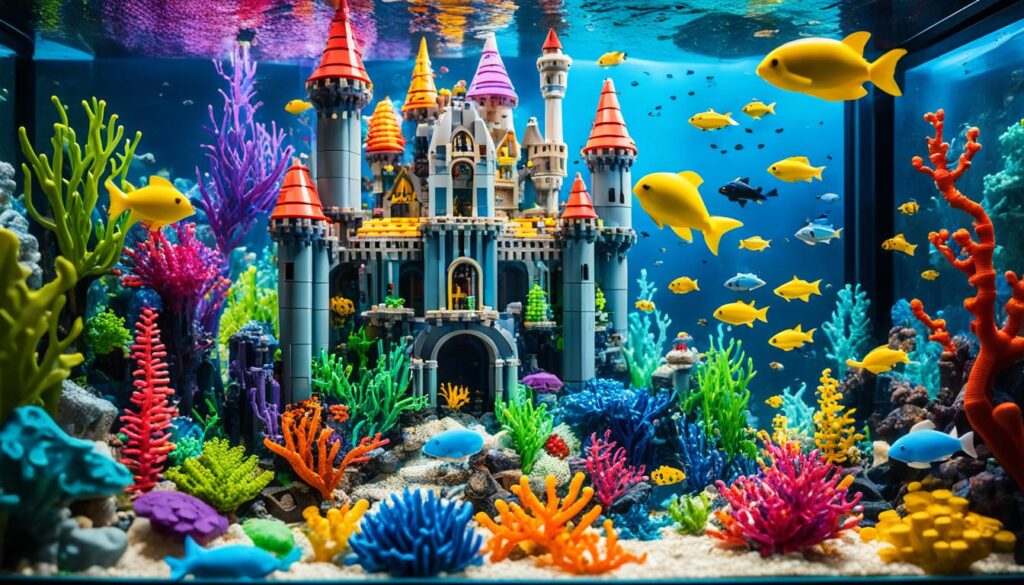
With Legos as your aquarium decor, you can create a visually stunning and engaging environment for your fish. Let your creativity flow and watch your underwater world come to life!
Making your Own DIY Aquarium Decorations
If you’re feeling crafty, it’s a great idea to make your own DIY aquarium decorations using materials from a craft store. Not only does it allow you to unleash your creativity, but it also ensures that you have full control over the design and safety of the decorations for your aquatic friends.
When making your own DIY aquarium decorations, it’s essential to prioritize the use of non-toxic materials. This ensures that your fish are not exposed to any harmful substances that could potentially endanger their health. At the craft store, look for materials that are specifically labeled as non-toxic and safe for aquatic environments.
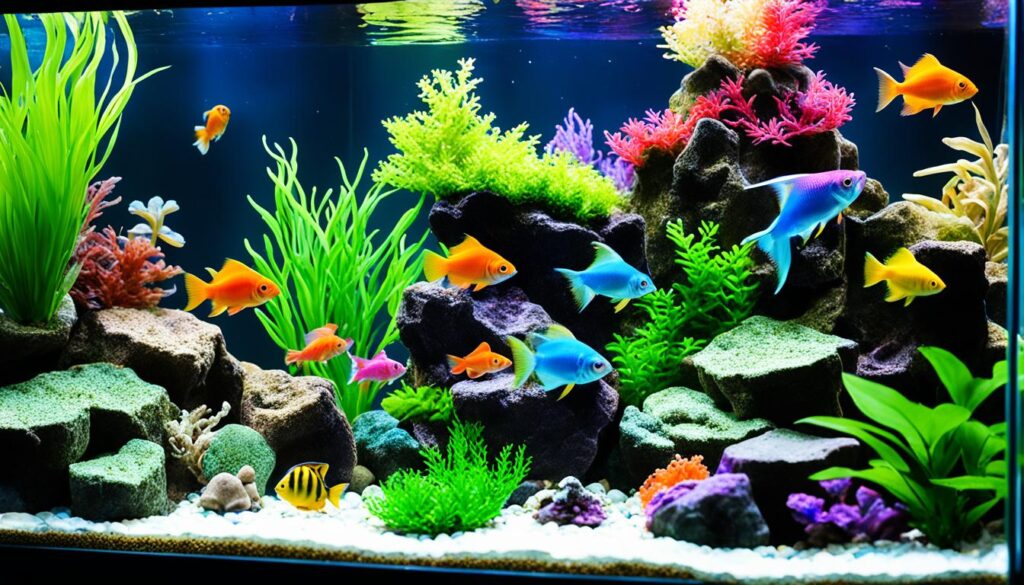
One versatile material that can be used for creating various shapes and forms is silicone. Silicone is non-toxic and can be easily molded to replicate rocks, corals, or other underwater elements. This gives you the flexibility to design and customize your aquarium setup according to your preference.
Before diving into your DIY project, it’s important to research and understand the suitability of materials for different aquatic species. Some fish may have specific requirements or preferences when it comes to tank decorations. By taking the time to educate yourself on the needs of your particular fish species, you can create a stimulating and safe environment for them to thrive.
To summarize, making your own DIY aquarium decorations allows you to add a personal touch to your tank while ensuring the safety of your aquatic friends. By getting creative with non-toxic materials from a craft store and using silicone to mold unique shapes, you can create a visually appealing and stimulating environment for your fish.
Conclusion
Choosing safe materials for DIY aquarium decor is crucial for the health and well-being of your aquatic friends. When creating your own underwater haven, it’s essential to follow guidelines and select aquarium-safe adhesives and materials to ensure the safety of your fish.
Whether you choose to repurpose household items, explore hardware stores, or unleash your creativity with building blocks like Legos, always prioritize the well-being of your aquatic pets. By carefully considering and researching the materials you use, you can create beautiful and safe DIY aquarium decorations.
Remember to choose adhesives such as cyanoacrylate glue, silicone sealant, epoxy, or hot glue guns that are safe for underwater use. Avoid using water-soluble glues or adhesives that can affect water quality. Consider using non-toxic paints, clear-coats, and acrylics to enhance the visual appeal of your aquarium decor.
With thoughtful planning and a commitment to using safe materials, you can transform your aquarium into a vibrant and personalized underwater paradise. Your fish will thrive in an environment that balances their natural needs with your creative expression. Start exploring the world of safe DIY aquarium decor today!
FAQ
How do I choose safe materials for DIY aquarium decor projects?
When selecting materials for DIY aquarium decorations, it’s important to consider their suitability and potential impact on water quality. Avoid using metal, as it can leach harmful chemicals into the water and even conduct electricity. Natural/organic materials should be used with caution, as they can decompose or affect water pH and hardness. Rocks and minerals can vary in their impact on water quality, and it’s essential to test them before adding them to the aquarium. Plain glass is safe, but painted or glazed glass may release harmful substances.
What kind of glue or adhesive should I use for aquarium decor?
When it comes to securing your DIY aquarium decorations, there are several options for glues and adhesives that are safe to use in aquariums. Cyanoacrylate glue, also known as “Reef Glue” or “Super Glue,” is commonly used by aquarists and reef hobbyists for bonding plastic materials. Silicone sealant is durable and more flexible once cured, making it suitable for assembling ornaments and pieces within the aquarium. Underwater epoxy is a two-part adhesive that is great for creating rockwork formations. Hot glue guns are non-toxic and easy to use for quick fixes in freshwater tanks. Avoid using water-soluble glues like white craft glue, as they will not cure and can affect water quality.
Can I use clear-coat paints and sealers for aquarium decor?
Clear-coat paints and sealers are popular for covering unsafe materials, but they cannot guarantee safety. Enamel paints are durable and can be used for underwater use once fully dried and cured. Acrylic paints are water-resistant and are commonly used by hobbyists, with Krylon Fusion paints being a popular choice. It’s important to follow the instructions for drying and curing to ensure the safety and longevity of the decorations.
Are there any household objects I can use for DIY aquarium decorations?
Yes, you can repurpose household objects as DIY aquarium decorations, adding a personal touch to your design. Plastics, such as toys, can be used safely and arranged to create fun scenes in the tank. Flowerpots, vases, and ceramic mugs can provide hiding spots and caves for fish. Ensure that the objects are free of sharp edges that could harm the fish.
Where can I find DIY decoration ideas for my aquarium?
If you don’t have suitable items at home, a hardware store or garden center can be a great source for DIY aquarium decorations. Lawn ornaments, such as garden gnomes or stone animals, can create interesting underwater scenes. Flower pots, vases, and fake plants can add unique elements to your aquarium design. PVP piping can be used to create tunnels and hiding spots for your fish.
Can I use Legos for DIY aquarium decorations?
Legos offer endless possibilities for DIY aquarium decorations. They are safe to use in water and allow for creative designs. You can either follow instructions from official Lego sets or create your own structures using a random selection of pieces. Ensure that larger structures have all the air bubbles removed, as they can cause floating. If using other building blocks, consider gluing them together with an aquarium-safe glue to ensure stability.
How can I make my own DIY aquarium decorations?
If you’re feeling crafty, you can make your own DIY aquarium decorations using materials from a craft store. Design your decoration and ensure that the materials you choose are non-toxic for the safety of your fish. Silicone can be used to mold and create various shapes for your aquarium setup. It’s important to research and understand the suitability of materials for different aquatic species.
How important is it to choose safe materials for DIY aquarium decor?
Choosing safe materials for DIY aquarium decor is crucial for the health and well-being of your aquatic friends. By following guidelines and selecting aquarium-safe adhesives and materials, you can create a vibrant and personalized underwater haven. Whether you repurpose household items, explore hardware stores, or unleash your creativity with Legos, make sure to prioritize the safety of your fish. With careful consideration and research, you can create beautiful and safe DIY aquarium decorations.
